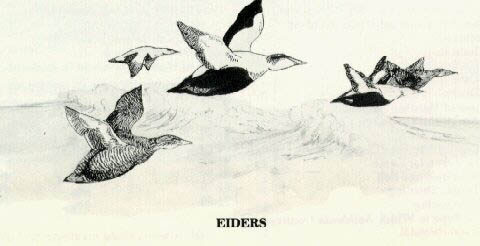
by: Fred Payne
June 1977

Off the coast of eastern Halifax county is a group of rock ledges, and partially treed or barren islands. Here in the cold and damp of spring, eider ducks have always made a nest in the tangle of brush, petrels built their nests in the shallow soils, and the rocks and grasses have held the nests of guillemots and gulls.
In the past the isolation of the birds' nests has been safeguarded by the fog and their remoteness. But, with the rising interest in islands as recreation sites and an increase in leisure time and public mobility, the future of these nesting sites might have been in danger.
On the 16th of November, 1976, the people of Nova Scotia, through the provincial cabinet, voted to give the islands legal protection and proclaimed them the Eastern Shore Islands Wildlife Management Area. The Area includes Round, Speck, Sutherland, Pumpkin, Horse, Brothers, Harbour, Beaver, Flag, High, Brokenback, Bird, Gold, Halibut, Little Goose, Tuffin, Frying Pan, Camp, White and Little White Islands. In total approximately 50 vegetated islands and islets and 10 non-vegetated islets or ledges comprise the management area.
The area will be used by scientists to learn more about the ecological interactions of island nesting birds and the successional stages important to each. A few selected islands will be managed specifically for eider or other colonial nesting species.
When someone enters a colony of nesting birds, the birds sitting on the nests are scared off without covering the nest as they normally would. The eggs and young birds are left unprotected so gulls and other predators may take a large toll. Eggs that are not eaten could be chilled and never hatch. So, to safeguard the future of the colony it's best that people stay off until the birds have raised their young. The Management Area is not closed to hunting during the regular hunting season, but it will be necessary to obtain a permit from the Minister of the Department of Lands and Forests to enter upon any island within the management area between April 1 and August 15. Licensed lobster fishermen will not, of course, need a permit to search for and retrieve lost fishing gear. Their cooperation is hoped for, to minimize disturbance of the birds.
At present, detailed vegetative and bird nesting inventories are being conducted on the islands. Our latest estimate suggests that approximately 2,000 eider ducks nest within the management area. This is one-fourth the total breeding population of this species in the province. The eider is a popular game duck in Nova Scotia and a high proportion of east and south shore hunters from Sydney to Cape Sable brave the coastal waters in pursuit of "ducks and drakes" or "sea ducks" as they are often called locally. Approximately 8,000 of these birds are harvested annually by Nova Scotia hunters. Ironically, band returns from young eider banded in Maine indicate that Maine's birds fly east to the south shore of Nova Scotia where some are harvested before the rest migrate south for the winter.
The eider well illustrates how game management has and can continue to work. from colonization to the early 1900's a gradual decline occurred, apparently resulting from egg collecting and shooting on the breeding islands in spring. Records around 1900 indicate less than a dozen pair on the Maine coast and "not more than two or three stay" in Nova Scotia to nest. Since the passing of the Migratory Bird Convention Act in 1916, the birds dramatically increased to about 18,000 pairs nesting in Maine and about 8,000 pairs nesting in Nova Scotia. These increases have occurred along with the coming of automatic shotguns, and greater numbers of hunters and predatory gulls.
No little part in the recognition of the importance of the Eastern Shore Islands is due the Nova Scotia Bird Society. This organization has leased the Halibut Islands, Gold Island, and the Bird Islands from the Department of Lands and Forests since April of 1960, and provided two caretakers to watch over the islands.
The Bird Society recognized the importance of habitat protection, harvest regulation and harvestable surplus, and they did what they could to implement good conservation. The Islands were not closed to hunting during the open hunting season but the Bird Society did provide the measure of control needed in the nesting season, without interfering with the privileges of the local people.
Coordinated efforts by interested conservation groups will do a great deal to ensure wise use of natural resources. While the Bird Society protected the Eastern Shore islands, hunters were helping the Department of Lands and Forests obtain bird sanctuaries in Yarmouth, Halifax, and Colchester Counties. United, all parties interested in wildlife gain, and have more to share. Divided we lose both natural resources and recreational opportunity.